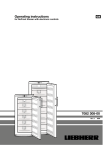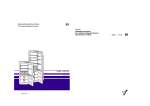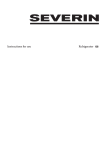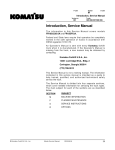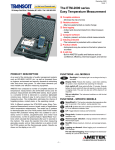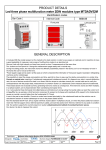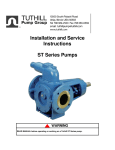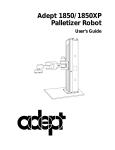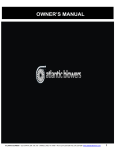Download Technical Service Data - Komatsu Forklift USA, Inc. v3.1
Transcript
F-code PS Section C-code M2.0 Technical Service Data Version no 003 T-code 395/396/397/398/399 Technical Service Data ! WARNING © Komatsu Forklift U.S.A., Inc. Master Service Manual When the battery is fully charged, performance may vary due to motor and system efficiency tolerance. Technical service data represents nominal values obtained under typical operating conditions. Specifications are subject to change without notice. 2001-09-18 57 F-code Section C-code M2.0 PS Technical Service Data Version no T-code 003 395/396/397/398/399 58 Master Service Manual 2001-09-18 F-code PS Version no 003 © Komatsu Forklift U.S.A., Inc. Master Service Manual 2001-09-18 Section C-code M2.0 Technical Service Data T-code 395/396/397/398/399 59 F-code Section C-code M2.0 PS Technical Service Data Version no T-code 003 395/396/397/398/399 60 Master Service Manual 2001-09-18 F-code PS Version no Section C-code M3.0 Ordering Spare Parts T-code 001 Ordering Spare Parts 1. Locate fault on truck. 2. Identify truck model, serial number, and battery voltage. 3. Locate page with the exploded diagram and find the item number for the part required. 4. Locate item number in table. Select the column for actual truck model and serial number. The following is an explanation of a serial number, * 2 = FR18S-2A, FR23S-2A; 3 = FR15DR-2A ** 4 = 24 volt; 6 = 35 volts *** 7 = 1997, 8 = 1998, etc. **** 1 = 198_, 2 = 199_, 3 = 200_ ***** FRS = FR18S-2A & FR23S-2A; FRD = FR15DR-2A ! CAUTION Although some trucks appear to be similar, component parts may not be interchangeable. If an incorrect part is used, the truck may malfunction. 5. Note part number. 6. Call your local Komatsu Forklift Dealer and state the part number. 7. If truck model, serial number, or article number cannot be found, call your local Komatsu Forklift Dealer for assistance. © Komatsu Forklift U.S.A., Inc. Master Service Manual 2000-08-04 61 F-code PS Version no Section C-code P Contents, Section P T-code 000 Contents, Section P 1. Planned Maintenance © Komatsu Forklift U.S.A., Inc. P1.0 INTRODUCTION, MAINTENANCE P2.0 SERVICE SCHEDULE P3.0 LUBRICATION CHART P4.0 OIL AND GREASE SPECIFICATIONS Master Service Manual 2000-08-04 63 F-code PS Section C-code P1.0 Introduction, Maintenance Version no T-code 000 Introduction, Maintenance The schedules of maintenance and lubrication given in this section of the Service Manual cover up to one year ’s operation of a truck. These schedules are based on hourly usage and can be adapted to suit most normal one shift patterns. The following hourly usage figures have been used when calculating the schedule: Single shift, 30 hours per week usage Double shift, 60 hours per week usage Triple shift, 90 hours per week usage The schedules are intended only as a guide, not as a rigid structure. Operators of trucks may wish to adapt them to local requirements; but it is emphasized that the schedules represent minimum manufacturer requirements, and all items should be included in a service program to ensure minimum downtime and a high safety status of the equipment. l Use only spare parts approved by Komatsu Forklift. l Always clean the equipment and carry out a full safety check after service. © Komatsu Forklift U.S.A., Inc. Master Service Manual 2000-08-04 65 F-code Section C-code P1.0 PS Introduction, Maintenance Version no T-code 000 1. Jacking Truck Off The Floor To perform maintenance that requires the truck to be lifted from the floor, observe the proper safety precautions as follows: 1. Lower the forks completely. Remove any load. 2. Turn key switch OFF and disconnect battery connector from the truck. 3. If possible, stabilize the top of the mast with an overhead chain hoist. 4. Before jacking the truck, check the stop block and adjustment bolt on the pivot plate to make sure they are in good condition. If the block or adjustment bolt are excessively worn or missing, take the truck out of service and contact your local Komatsu Forklift Product Support Representative. ! WARNING Use extreme care whenever the truck is jacked up for any reason. Never block the truck between the mast column and floor. Use a suitable hoist to stabilize the mast. Keep hands and feet clear from beneath truck while jacking. Use jack stands or solid blocks to support the truck, do not rely on jacks. 5. Place the jack under the designated jacking points. 1.1. Elevate Rear of Truck 1. Place the jack in the designated jacking position. 2. Jack the rear of the truck so the drive tire is off the floor no more than 3 inches (76 mm). 3. Block truck in place. 66 Master Service Manual 2000-08-04 F-code PS Section C-code P1.0 Introduction, Maintenance Version no T-code 000 1.2. Elevate Either Side of Truck 1. Place the jack in the designated jacking position. 2. Jack the side of the truck so that the load wheel is off the floor no more than 0.50 inch (12.7 mm). 3. Block truck in place. © Komatsu Forklift U.S.A., Inc. Master Service Manual 2000-08-04 67 F-code Section C-code P1.0 PS Introduction, Maintenance Version no T-code 000 2. Lubricants 2.1. Standard For reach trucks in their standard design under continuous operation, the recommended ambient temperature is 23° F (5° C). These trucks should apply to the following guidelines: l Parked outside storage when not in use l Charging and maintenance work to be done outside storage 2.2. Corrosion In an environment where a damp, wet, or corrosive condition exits, these trucks apply to the following guidelines: l All hardware coated with LPS Rust Inhibitor during and/or after assembly l Sealed components (switches, push/pull cables, sensors, etc.) where appropriate l Grease fittings provided on axle and other pivot points l Plated pins, shafts and linkage where required l All electrical connections coated with Dow Corning No. 4 compound during assembly l Lift chains coated with Libriplate chain protectant l Components coated with LPS Cold Galvanize where appropriate l Components (adjustable features, bearing races, etc.) coated with Antisieze where appropriate 2.3. Cold Storage To prevent moisture contamination in the electrical system, trucks equipped with cold storage conditioning packages have electrical compound applied to all electrical connections during assembly. For cold storage reach trucks with continuous operation, the recommended ambient temperature is 5° F (-15° C). Cold storage trucks should apply to the following guidelines: 68 Master Service Manual 2000-08-04 F-code PS Version no Section C-code P1.0 Introduction, Maintenance T-code 000 l l l l Trucks completely dry prior to commencing the continuous stay in the cold storage Parked inside the cold storage for operator breaks Charging and maintenance work done outside the cold storage Trucks completely dry before returning to continuous cold storage operation For cold storage reach trucks with intermittent operation, the recommended ambient temperature is - 13° F (-25° C). Trucks apply to the following guidelines: l Surface condensation occurs, “wet” trucks should neither remain idle in the cold storage for no longer than 10 minutes nor operate inside the cold storage for extended periods l Condensation must not be allowed to freeze on the truck at any time l Park outside the cold storage for operator breaks l Charging and maintenance work to be done outside the cold storage Items included in the cold storage package are as follows: l All corrosion conditioning items l Sealed components used in all non-heated locations l Heavy-duty mechanical switches used where appropriate l Thermostat controlled heaters used to prevent moisture buildup in electrical component areas l Heaters located around the electronic card, the drive and lift power controllers, the steering tachometer, and hydraulic control potentiometers l Windshield replaced with a screen l Hydraulic fluid in lift/auxiliary system changed to ATF l Anti-seize compound used on the control console, vertical adjustment bar l Standard grease replaced with Mobiltemp SHC 32 lubricating grease © Komatsu Forklift U.S.A., Inc. Master Service Manual 2000-08-04 69 F-code Section C-code P1.0 PS Introduction, Maintenance Version no T-code 000 2.4. Freezer Storage To prevent moisture contamination in the electrical system, trucks equipped with freezer storage conditioning packages have electrical compound applied to all electrical connections during assembly. For freezer storage reach trucks with continuous operation, the recommended ambient temperature is -31° F (-35° C). Trucks should apply to the following guidelines: l Trucks must be parked inside the freezer for operator breaks l Trucks stay in the freezer during battery charging or change-out (If truck is removed from freezer for maintenance work or battery charging, it must be completely dry before reentering the continuous shift in the freezer) Items included in the freezer storage package are as follows: l All cold storage items contained l Transmission fluid in the lift/auxiliary system will be changed to Texaco 15 l Cooling fan in the component compartment will be disconnected. 70 Master Service Manual 2000-08-04 F-code Section PS P2.0 Service Schedule Version no 002 C-code T-code 395/396/397/398/399 Service Schedule 1. Planned Maintenance Schedule © Komatsu Forklift U.S.A., Inc. Master Service Manual 2000-08-04 71 F-code Section C-code P2.0 PS Service Schedule Version no T-code 002 395/396/397/398/399 72 Master Service Manual 2000-08-04 F-code Section PS P2.0 Service Schedule Version no 002 © Komatsu Forklift U.S.A., Inc. Master Service Manual 2000-08-04 C-code T-code 395/396/397/398/399 73 F-code Section C-code P2.0 PS Service Schedule Version no T-code 002 395/396/397/398/399 74 Master Service Manual 2000-08-04 F-code Section PS P2.0 Service Schedule Version no 002 © Komatsu Forklift U.S.A., Inc. Master Service Manual 2000-08-04 C-code T-code 395/396/397/398/399 75 F-code Section C-code P2.0 PS Service Schedule Version no T-code 002 395/396/397/398/399 2. Planned Maintenance Procedures This section describes how to perform the services listed in the Schedule of Planned Maintenance Operations. As with the “Schedule”, this section is subdivided into service intervals. 2.1. Services Performed Daily or Every 8 Operating Hours The daily inspection is to be made by the operator prior to each operating shift. It is the operator’s responsibility to report any defects to the proper authorities. The truck should not be operated until it has been inspected and repaired by a trained, qualified, and authorized technician. The operator is ultimately responsible for the safe operation of reach truck. 2.1.1. Battery Discharge Indicator with slow down The battery discharge indicator indicates the current charge status of truck’s battery. (See “Battery Discharge Indicator Parameter Adjustment” on page 384.) 1 1/2 0 Full charge battery Half charged battery Discharged battery The battery discharge indicator has an integrated cut-out function that slows down truck’s lift function when a predetermined charge level has been reached. This prevents overloading the battery and increases the operating economy of truck. When the battery has reached a charge level equivalent to 70% discharge, a warning signal is given via flashing lights. A further 10% of the battery’s capacity can then be used before the battery discharge indicator slows down the lift function. 2.1.2. Hydraulic System Inspect entire truck for leaks, especially around hydraulic pump assembly and lift cylinders. Any sign of oil on the floor under truck is an indication that truck may be leaking hydraulic oil or transmission fluid. Report any problems to the proper authorities, and DO NOT operate truck until it has been inspected and repaired by a trained, qualified, and authorized technician. 76 Master Service Manual 2000-08-04 F-code Section PS P2.0 Service Schedule Version no 002 C-code T-code 395/396/397/398/399 2.1.3. Frame/Sheet Metal Inspect truck for loose, damaged or missing parts. All shields must be in place and functional. Report any problems to the proper authorities. DO NOT operate truck until it has been inspected and repaired by a trained, qualified, and authorized technician. 2.1.4. Wheels/Tires Inspect wheels and tires for wear and damage. Trash that is wrapped around wheels and axles will cause premature tire wear and bearing damage. The floors should be kept clear of trash to prevent damage to wheels and tires. 2.1.5. Functions/Operations Test truck for the proper operation of all functions including the travel controls, lift and lower functions, brakes, and emergency disconnect button. Safety devices must be operational. Report any problems to the proper supervisors. DO NOT operate truck until it has been inspected and repaired by a trained, qualified, and authorized technician. 2.2. Services Performed Monthly or Every 120 Operating Hours The monthly planned maintenance service should be performed by a trained, qualified, and authorized technician. 2.2.1. Inspection All services and inspections listed above for the daily inspection should be performed at this time. The inspection procedure should be more thorough, and minor deficiencies should be corrected. 2.2.2. Transmission Inspect for oil leakage. 2.2.3. Brakes When the foot is lifted from the brake pedal it should stop a fully loaded truck at full speed in approximately one truck length. © Komatsu Forklift U.S.A., Inc. Master Service Manual 2000-08-04 77 F-code Section C-code P2.0 PS Service Schedule Version no T-code 002 395/396/397/398/399 2.2.4. Battery Contact your battery dealer for specific instructions on care and maintenance of the battery. An average battery will have a specific gravity of 1.170 at the 80% discharged level. However, there are many different batteries on the market. Only the battery manufacturer can accurately determine the fully charged and 80% charged levels. Contact the battery manufacturer for this information. 2.2.5. Electrical Connections Check that all electrical connections are clean and tight. Plugin connectors should be unplugged and plugged back in to clean terminals. If the truck is equipped with any of the coldstorage, freezer use, or corrosive environment application packages, the di-electric compound in the plug-in connectors should be renewed. 2.2.6. Contactor Tips (NOT Sealed) Inspect contactor tips for arcing, pitting, or burning. Minor pitting of the tips is not a problem. However, if tips are pitted through the tip to the copper bar, tips should be replaced. DO NOT file tips. Replace tips only in complete sets. Some contactors have concealed tips or fully sealed so tips cannot be replaced. 2.2.7. Motor Brushes The drive motor and pump motor are equipped with a brush wear sensor which will indicate when brushes need replacing. For minimum brush length see page 57. As a rule of thumb, brushes should be replaced if brush spring is within 0.0625 inch (1.59 mm) of touching brush holder. 2.2.8. Drive Motor Blow out drive motor fan and vents. Check for any signs of oil on drive motor fan and air vents. Check for any damage to fan or air vents. ! WARNING 78 Compressed air used for cleaning MUST be reduced to less than 30 psi (206 kPa) and then only with effective chip-guarding and personal protective equipment worn. Master Service Manual 2000-08-04 F-code Section PS P2.0 Service Schedule Version no 002 C-code T-code 395/396/397/398/399 2.2.9. Hydraulic Reservoir Check fluid level in the hydraulic reservoir. 2.2.10. Frame Lube The pressure type grease fittings (zerk fittings) should be lubricated with grease (see page 84). The total number of grease fittings depends on truck options when built (see page 83). A truck with a cold-storage, freezer use, or corrosive environment application package will have more grease fittings than a standard truck. Look for flush-type grease fittings on the load wheel axles. Regular fittings may be found on the transmission mounting bearing and mast chain sheave shafts. 2.2.11. Pivot Points There are pivot points and other items that need to be lubricated but do not have grease fittings. Lubricate these non-greasable wear points with a drip oil can using 10 weight machine oil. © Komatsu Forklift U.S.A., Inc. Master Service Manual 2000-08-04 79 F-code Section C-code P2.0 PS Service Schedule Version no T-code 002 395/396/397/398/399 2.3. Services Performed Every 480 or 960 Operating Hours The planned maintenance service should be performed by a trained, qualified, and authorized technician. 2.3.1. Drive Motor Since the operating environment of material handling equipment varies widely, the following recommendations are suggested for periodic maintenance inspections for the drive motor armature. l Normal Service 8 hours per day operation l Routine inspection every 960 hours (8 months). l Severe Service 24 hours of daily operation 1. Dusty or sandy locations; such as a cement plant, lumber or flour mills, coal dust or stone-crushing areas. 2. High temperature areas; such as steel mills, foundries, etc. 3. Sudden temperature changes (continuous in-dooroutdoor movement) that is refrigeration plant, etc. l 80 Routine inspection every 480 hours (4 months). Master Service Manual 2000-08-04 F-code Section PS P2.0 Service Schedule Version no 002 C-code T-code 395/396/397/398/399 2.4. Services Performed Annually or Every 1440 Operating Hours The annual planned maintenance service will take a longer period of time to complete than does the monthly service. This would be a good time to arrange other repairs that have been noted on the monthly service. 2.4.1. Inspection All services and inspections listed for the daily and monthly inspection should be performed at this time. The inspection procedure should be more thorough, and minor deficiencies should be corrected. 2.4.2. Transmission The transmission fluid should be drained once a year. The drain port is located on the lower portion of the side cover opposite the drive tire. Remove bolt to drain transmission fluid. Flush transmission case. Pour a clean solution into the fill port accessed from the battery compartment. With the drive tire off the floor, allow solution to run out of drain port while transmission is running. Stop flushing when the solution runs clean. Allow the solution to drain well before replacing drain plug bolt. Replace drain plug bolt. Refill transmission with proper clean oil before operating truck. 2.4.3. Battery At approximately 1500 hours, contact an authorized battery dealer to determine the overall condition of the battery. Determine if the battery needs to be washed down. This can only be done by properly trained, qualified, and authorized technician. © Komatsu Forklift U.S.A., Inc. Master Service Manual 2000-08-04 81 F-code Section C-code P2.0 PS Service Schedule Version no T-code 002 395/396/397/398/399 2.4.4. Hydraulic System The hydraulic system should be drained, flushed and refilled, and the pressure relief valve setting should be checked and adjusted. This will maintain proper lubrication properties within the system. ! WARNING Before siphoning oil from reservoir, make certain siphon is clean. To drain reservoir, remove reservoir filter assembly. Siphon oil from reservoir and purge oil out of hydraulic system. Fill reservoir with proper clean oil. Operate the raise and lower function several times to purge air from the system. Check oil level. Put rated truck capacity load on forks and adjust pressure relief valve, if necessary, so that truck will lift rated load. 2.4.5. Brakes Follow procedures for brake removal before inspecting. Remove brake assembly and inspect friction disc for wear. The friction disc should be replaced once thickness is 0.25 inch (6 mm) or less. The armature and magnetic coil should be adjusted if machine will not meet stopping and holding specifications. The air gap should not exceed 0.018 inch (0.46 mm) and should remain within 0.003 inch (0.076 mm) throughout the circumference. 2.4.6. Lift and Carriage Chains Lift and carriage chains should be checked every 720 hours. A chain gauge should be used to check stretch of the links. To adjust inner columns, loosen jam nut and tighten chains equally until the top of the columns are level in the fully lowered position. Retighten jam nut and torque. Carriage chains should be adjusted in the fully lowered position. Adjust chains until the top of forks are 2.0 inches (50.8 mm) off of the floor. 82 Master Service Manual 2000-08-04 F-code Section PS P3.0 Lubrication Chart Version no 001 C-code T-code 395/396/397/398/399 Lubrication Chart L = Lubrication C = Check O = Oil change Truck Lubrication Points © Komatsu Forklift U.S.A., Inc. Master Service Manual 2000-08-04 83 F-code Section C-code P4.0 PS Oil and Grease Specifications Version no T-code 001 395/396/397/398/399 Oil and Grease Specifications 1. Approved Oils and Grease * Refer to section 10000 of Parts Book for special lubricants. 84 Master Service Manual 2000-08-04 F-code Section C-code P4.0 PS Oil and Grease Specifications Version no 001 T-code 395/396/397/398/399 2. Grease Location Points © Komatsu Forklift U.S.A., Inc. Master Service Manual 2000-08-04 85 F-code Section C-code P4.0 PS Oil and Grease Specifications Version no T-code 001 395/396/397/398/399 3. Mast Adjustment Points 86 Master Service Manual 2000-08-04




























